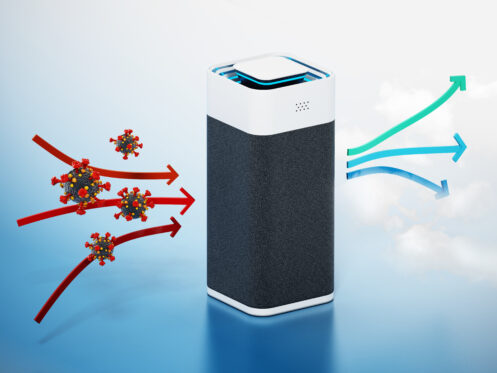Issues with indoor air quality (IAQ) in your Wilmington, NC home can impact your health and even point toward issues with the integrity of your home. Many things can negatively impact your indoor air quality, such as pet dander, pollen, mold spores, dust, volatile organic compounds (VOCs), and more.
While some contaminants are easier to spot than others, you may be dealing with unhealthy indoor air quality and not even realize the connection. While a professional indoor air quality assessment is a great way to determine what particulates are in the air you’re breathing, there are other signs to watch out for as well.
Signs of Low Indoor Air Quality
Some people show more sensitivity to air contaminants than others. Keep in mind, though, that many of the more dramatic symptoms of poor IAQ may only show up over a long period of exposure. More minor symptoms, like allergies, can pop up much sooner. Here are some of the most common symptoms of poor indoor air quality.
Allergies
Wilmington experiences some high levels of pollen in the spring and summer months, which can impact your indoor air quality. However, there are other particulates that may be in your home that are also causing the typical allergy symptoms, like a runny nose, itchy eyes, scratchy throat, cough, and so on. Other common culprits include pet dander, dust, dust mites, mold, and volatile organic compounds. Some of these symptoms can be improved with the use of an antihistamine or other allergy medicine, while others may not. These symptoms are generally very consistent, regardless of the season. They may worsen over time as well.
Respiratory Issues
IAQ problems are particularly problematic for people with asthma, a chronic respiratory condition where your airways narrow and restrict your breathing. Many different things can trigger asthma attacks, such as exercise, but so can low IAQ. This is especially important if you spend a lot of time indoors. Of course, asthma isn’t the only condition that impacts the respiratory system. Even if your allergies don’t flare up as a result of poor IAQ, you may find it harder to breathe than normal when indoors. Advanced filtration is a great way to cut back on indoor pollutants while reducing asthma symptoms.
Overall Health Problems
While poor indoor air quality may begin with basic allergy-like symptoms, ongoing long-term exposure to pollutants can result in some pretty serious health problems. High levels of histamine and mast cells in the body can lead to chronic inflammation that damages the gut and other organs. An increased risk of lung cancer can come from ongoing exposure to cigarette smoke and radon gas. Volatile organic compounds can lead to chronic migraine headaches, dizziness, and trouble breathing if your space isn’t ventilated properly.
Excess Moisture
Not all signs of indoor air quality issues will be health-related. When you have high levels of humidity in your indoor air, mold thrives very quickly. It’s more common in bathrooms, kitchens, and laundry rooms, but mold can also thrive in your ductwork, behind walls, or on your ceilings and circulate through your air. While some mold spores aren’t visible to the naked eye, you should watch out for mold growth under sinks, in your basement, around your showers and tubs, etc. If you have spotted large areas with mold accumulation, you should reach out to a remediation company for prompt removal. A professional can remove the mold without increasing your risk of exposure. You should also investigate the source of the mold, such as a leaky pipe or a lack of enough air circulation.
Inefficient Air Exchange
Air needs to circulate throughout your home to maintain healthy indoor air quality. This also includes the exchange of air between your home and the outdoors. One major sign of inefficient air exchange is that odors take forever to leave your home. For example, if you cooked breakfast, returned home hours later, and can still smell that same food, there wasn’t adequate circulation and air exchange while you were gone. If you can smell chemical fragrances or cleaning products, chances are that VOCs associated with them are still lingering in your home.
Not every odor in your home comes from specific actions you do, though. As another example, a musty smell throughout the home can mean you have moisture issues that may be causing mold growth. (Better air exchange can help with that scent, but it can also help regulate humidity and reduce the likelihood of mold growing.) Being able to smell your pets when you walk in the door likely means that you also have a high presence of dander that can cause allergy symptoms.
You may need to make improvements to areas like the kitchen or bathrooms, but some homes are just set up in a way that doesn’t allow for ample air exchange. Try running your interior exhaust fans more often, opening your windows for a short period of time each day, and running your heating and cooling equipment regularly.
Air filtration can also help improve indoor air quality. HEPA filters can catch up to 99.97% of the particulate matter that tends to circulate indoors. (Think bacteria, dust, and so on.) However, they shouldn’t be used with residential HVAC systems unless specified, as they can restrict airflow and cause issues. Purifiers with HEPA filters included, however, are a great solution. Activated carbon can catch some of what HEPA filters can’t, such as smoke and VOCs.
If moisture is a concern, a dehumidifier can remove excess humidity so that levels remain between 30% and 50%. You should also address other sources of moisture that may be causing a mildew-like smell, such as a damp basement, a leaky foundation, leaky pipes, a lack of insulation in certain rooms, etc.
Hot and Cold Spots
If you have areas of the home that are inconsistent in regard to temperature, this means your air is not circulating well through your HVAC system. This will prevent proper filtration of your indoor air, exposing you to more contaminants. Having a professional inspect your HVAC system can help determine the cause of your hot and cold spots. You may not have an adequately sized furnace or air conditioner. Ductwork may be damaged and in need of repair. There are various steps you can take to reduce these hot and cold spots and boost air circulation and filtration. Make sure all your air register vents are open. You may be tempted to close off certain rooms that aren’t used very often to save money. Unfortunately, this can lead to poor indoor air quality because of decreased airflow.
If you would like to learn more about the importance of indoor air quality and how you can make improvements in your Wilmington home, reach out to Green Dot Heating & Air for assistance. We can perform an indoor air quality assessment to help you determine what’s plaguing your air quality. This allows us to make recommendations for ways you can make improvements, from air purification devices to humidity control. We also take care of new heating and cooling installations, emergency repairs, and routine maintenance. Reach out to the team at Green Dot Heating & Air today to schedule an appointment.








